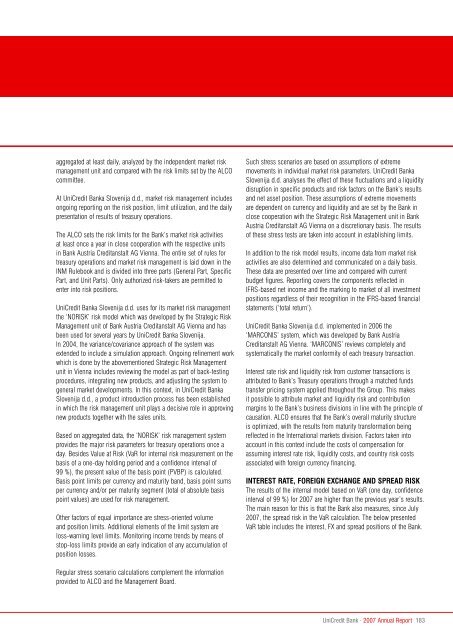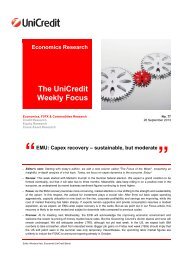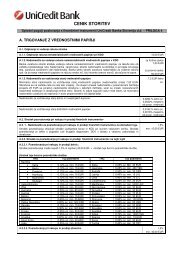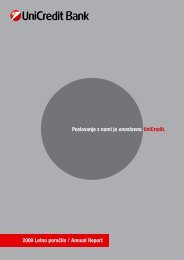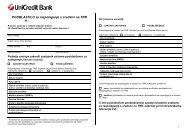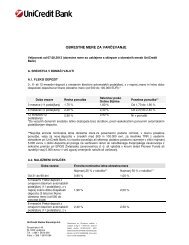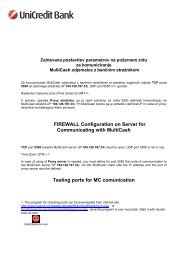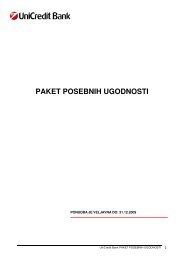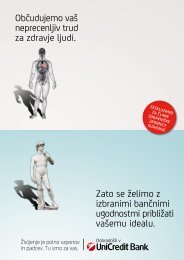Letno poroÄilo 2007 - UniCredit Banka Slovenija dd
Letno poroÄilo 2007 - UniCredit Banka Slovenija dd
Letno poroÄilo 2007 - UniCredit Banka Slovenija dd
You also want an ePaper? Increase the reach of your titles
YUMPU automatically turns print PDFs into web optimized ePapers that Google loves.
aggregated at least daily, analyzed by the independent market riskmanagement unit and compared with the risk limits set by the ALCOcommittee.At <strong>UniCredit</strong> <strong>Banka</strong> <strong>Slovenija</strong> d.d., market risk management includesongoing reporting on the risk position, limit utilization, and the dailypresentation of results of treasury operations.The ALCO sets the risk limits for the Bank’s market risk activitiesat least once a year in close cooperation with the respective unitsin Bank Austria Creditanstalt AG Vienna. The entire set of rules fortreasury operations and market risk management is laid down in theINM Rulebook and is divided into three parts (General Part, SpecificPart, and Unit Parts). Only authorized risk-takers are permitted toenter into risk positions.<strong>UniCredit</strong> <strong>Banka</strong> <strong>Slovenija</strong> d.d. uses for its market risk managementthe ‘NORISK’ risk model which was developed by the Strategic RiskManagement unit of Bank Austria Creditanstalt AG Vienna and hasbeen used for several years by <strong>UniCredit</strong> <strong>Banka</strong> <strong>Slovenija</strong>.In 2004, the variance/covariance approach of the system wasextended to include a simulation approach. Ongoing refinement workwhich is done by the abovementioned Strategic Risk Managementunit in Vienna includes reviewing the model as part of back-testingprocedures, integrating new products, and adjusting the system togeneral market developments. In this context, in <strong>UniCredit</strong> <strong>Banka</strong><strong>Slovenija</strong> d.d., a product introduction process has been establishedin which the risk management unit plays a decisive role in approvingnew products together with the sales units.Based on aggregated data, the ‘NORISK’ risk management systemprovides the major risk parameters for treasury operations once aday. Besides Value at Risk (VaR for internal risk measurement on thebasis of a one-day holding period and a confidence interval of99 %), the present value of the basis point (PVBP) is calculated.Basis point limits per currency and maturity band, basis point sumsper currency and/or per maturity segment (total of absolute basispoint values) are used for risk management.Other factors of equal importance are stress-oriented volumeand position limits. A<strong>dd</strong>itional elements of the limit system areloss-warning level limits. Monitoring income trends by means ofstop-loss limits provide an early indication of any accumulation ofposition losses.Such stress scenarios are based on assumptions of extrememovements in individual market risk parameters. <strong>UniCredit</strong> <strong>Banka</strong><strong>Slovenija</strong> d.d. analyses the effect of these fluctuations and a liquiditydisruption in specific products and risk factors on the Bank’s resultsand net asset position. These assumptions of extreme movementsare dependent on currency and liquidity and are set by the Bank inclose cooperation with the Strategic Risk Management unit in BankAustria Creditanstalt AG Vienna on a discretionary basis. The resultsof these stress tests are taken into account in establishing limits.In a<strong>dd</strong>ition to the risk model results, income data from market riskactivities are also determined and communicated on a daily basis.These data are presented over time and compared with currentbudget figures. Reporting covers the components reflected inIFRS-based net income and the marking to market of all investmentpositions regardless of their recognition in the IFRS-based financialstatements (‘total return’).<strong>UniCredit</strong> <strong>Banka</strong> <strong>Slovenija</strong> d.d. implemented in 2006 the‘MARCONIS’ system, which was developed by Bank AustriaCreditanstalt AG Vienna. ‘MARCONIS’ reviews completely andsystematically the market conformity of each treasury transaction.Interest rate risk and liquidity risk from customer transactions isattributed to Bank’s Treasury operations through a matched fundstransfer pricing system applied throughout the Group. This makesit possible to attribute market and liquidity risk and contributionmargins to the Bank’s business divisions in line with the principle ofcausation. ALCO ensures that the Bank’s overall maturity structureis optimized, with the results from maturity transformation beingreflected in the International markets division. Factors taken intoaccount in this context include the costs of compensation forassuming interest rate risk, liquidity costs, and country risk costsassociated with foreign currency financing.Interest rate, foreign exchange and spread riskThe results of the internal model based on VaR (one day, confidenceinterval of 99 %) for <strong>2007</strong> are higher than the previous year’s results.The main reason for this is that the Bank also measures, since July<strong>2007</strong>, the spread risk in the VaR calculation. The below presentedVaR table includes the interest, FX and spread positions of the Bank.Regular stress scenario calculations complement the informationprovided to ALCO and the Management Board.<strong>UniCredit</strong> Bank · <strong>2007</strong> Annual Report 183


